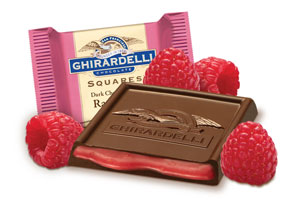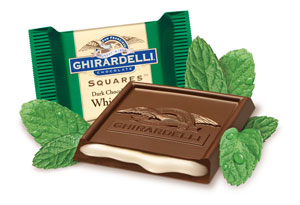A brief lesson in branding, as I taught it in my Juilliard class this week.
I brought in a Plugbug, and some chocolate. I’d bought the Plugbug in an Apple store, though it’s not made by Apple. It’s a power adapter for Apple products, and — unlike anything Apple sells — can charge two things at once, my MacBook and my iPhone or iPad.
Apple’s power adapters — the ones that come with their laptops and i-devices — are white. And while the Plugbug looks much like an Apple charger, it’s red, so we’ll know it’s different.
Now for the chocolate. I keep a tray of chocolate at home. The everyday items in it are assorted Hershey’s Nuggets, which come in three varieties, each wrapped in different colors:
- Milk chocolate — wrapped in silver
- Dark chocolate and almonds — there’s a lot of dark brown in the wrapping.
- Creamy milk chocolate, with toffee and almonds — gold wrapping
The nuggets look different, so you always know which one you’re choosing.
But then, moving upscale, I’ve also got Ghirardelli Squares. Bigger than the Nuggets, but much thinner, and differently shaped. Square. Differentiated from Hershey’s, and all other brands.
And from each other! Again, each flavor is wrapped in colors of its own:

- The dark chocolate squares with raspberry filling have wrapping edged in pink.
- The intense dark chocolate squares are wrapped in black.
- And the dark chocolate squares with white mint filling have wrapping edged in green. (Which doesn’t contradict the mint being white, because green is the color we all associate with mint.)
All of which of course is pretty basic. The Plugbug is red, so we’ll know it’s not a standard Apple product. The chocolates are shaped and wrapped in different ways, so we’ll know which ones they are.
But here’s the lesson for musicians. If you give a concert — or a concert you give is advertised — how do we know it’s you?



Good point. Very good point.
Distinctiveness, not only when playing (would be a topic for itself), but also in advertisements.
How many well-trained classical musicians hold a fan base that exceeds their friends and colleagues? Unless it’s about real stars, it’s mostly the feeling of “yet another instrumentalist”. Will most likely play fine, but could be replaced by any other artist without substantial loss. And being replacable doesn’t help when you want to get good deals, or even want to become commonly known.
One could have a look at Heavy Metal amateurs. It’s quite common there that a starter band has developped a distinguishable logo before they even had three rehearsals. I suspect it’s mostly about feeling like superstars, and I’ve to grin whenever I see the crafted, quite professionally looking logo of a band in which no-one played his instrument three months ago, but… it works. You’ll find many bands like this who do have a significant local fan base. Their logo is not the single reason for it, but sure helps quite a lot. I’d – totally unfounded by any express research – call it 30%.
(PS – Not that I’m terribly eager to listen to badly played Metal, but one can learn everywhere. I’d recommend slightly more decency, though, when developping a logo in classical music.)
“Branding” is a term one hears a lot out here in Hollywood. For example, there is “branding integration,” which is the new euphemism for “product placement” (prominent display of products in movies and TV shows as subliminal — or not so subliminal — advertising). Then there is “branded entertainment,” which is the new term for what we used to call entertainment “franchises.” “Branded entertainment” is regarded as having a high value because it has a high name recognition factor for the audience, and thus requires less P&A (advertising/marketing expense) to make the public aware of it and interested in paying to see it. Branded entertainment includes remakes of movies and TV shows with known titles, sequels, films based on comic books, etc. Of the biggest box office successes of 2011, at least five of them were sequels, which is a lot. The principle behind branding (and branded entertainment) is that it is easier to sell the public something old (something they are already familiar with, even if it’s only a matter of name recognition) than it is to sell them something new, where you have to break through the noise to get their awareness and attention, let alone to convince them to go to the movies or order the DVD on Netflix.
How any of this relates to your lecture today or to classical music I am not sure. Maybe you could say that Beethoven is a “brand” but Luigi Nono is not. Or perhaps it’s just that people are like Pavlov’s dogs and respond automatically to certain familiar stimuli — but shut out unfamiliar ones.
Ideally one would want the ‘branding’ to reflect some truth or reality in the artist just as the Hershey Nugget wrappers reflect what is inside. A lot of the younger artists seem to have grasped this very well. Yuja Wang and Khatia Buniatishvili have a flashy, sexy image that is borne out it their performances (which also tend to be flashy and, uh, well, a tad superficial). Here’s my post on that:
http://themusicsalon.blogspot.com/2011/08/classical-music-with-pop-sensibility.html
Now the problem is, what if your approach to the music is a little less flashy? What if you are a young Grigory Sokolov? Here’s a post on him:
http://themusicsalon.blogspot.com/2011/07/grigory-sokolov.html
How do you ‘brand’ yourself in that situation? You see, here is what I think is going on. The tail is wagging the dog. A young artist is looking for a way to make an impact. The only sure way these days, it seems, is to be flashy and sexy. So that’s the image that is adopted. And the musical personality seems to follow the visual one. Because if your musical personality is more like Sokolov or Friedrich Gulda, and you brand yourself according to your nature, it will NOT be flashy and sexy and no-one will notice you.
What I’m wondering is how long it will take us to get tired of what I am tempted to call “fashion-model pianists”?
“One would want the ‘branding’ to reflect some truth or reality in the artist” (Bryan Townsend in his comment)
This is a core truth in the “branding business” (in which I had to work years ago). A brand that does not reflect what the audience will really experience won’t hold a long time. Ideally, the brand is an amplification of what the product / company / artist stands for, something like a one paragraph excerpt of a long novel.
It doesn’t have to be “a flashy, sexy image”, either. You know the classical record most respected (and, yes, also heard) among those friends of mine who are from outside classical music, but have a good taste in the music they love? It’s Gould’s Goldberg variations, the early one. No “sexy, flashy” attitude; people enjoy a music that concentrates life into the sound of one sole piano, which often even plays just two parallel lines.
Gould’s image is something to analyze, too. His humming, conducting himself, playing on an old stool, stopping to give concerts at the age of 31… nothing that any PR expert would have advised him to do. But something that made him an individual, someone whom the public believed that he was into music because of his personality, not because of money or fame.
Also, have a look at nerds: on he internet, there are so many household names nowadays who sure wouldn’t apply for “sexiest man/woman alive”. Both they and their many fans know that they just don’t need that type of image.
If I was a young Grigory Sokolov (@Bryan Townsend: great find, the first video in Your article! Truly compelling), I’d brand myself somewhere along the lines of Peanuts’ Schroeder. Which is a character definitely liked by the public, inspite of NOT being cool, NOT being a baseball winner, NOT flirting with Lucy but keeing to Beethoven instead. The wikipedia article ( http://en.wikipedia.org/wiki/Schroeder_%28Peanuts%29 ) shows it in the very second sentence: “He is distinguished by his precocious skill at playing the toy piano, as well as by his love of classical music and the composer Ludwig van Beethoven in particular”. “Distinguished” – that’s what good branding is about.
One of the big problems I can see with branding is similar to the issue of typecasting that actors in theater or the cinema can face. If you get too well known as a “specialist” in one particular field, genre, or style then that could possibly limit your ability to get work. This is almost at odds with what Dick Weissman says to do especially in smaller musical markets. He does say that in bigger musical markets the ability to be well known in a particular style is likely to be sustainable in ways that it might be possible to achieve outside of areas where music isn’t so saturated (then the obvious problem of branding becomes an issue because how do you stand out from, say, the other thousands of new music specialists you’re competing with?).
And I guess that’s the issue, how much branding is going to be helpful? You have to know your particular musical environment and the genres of music that are relatively profitable as well as the relative density of musical activity in it.
“Gould’s image is something to analyze, too. His humming, conducting himself, playing on an old stool, stopping to give concerts at the age of 31… nothing that any PR expert would have advised him to do. But something that made him an individual, someone whom the public believed that he was into music because of his personality, not because of money or fame.”
There is no point in analysing Glenn Gould’s image and trying to imitate him, it was the result of being high functioning autistic. There same as Andy Warhol’s blank stare, which was also the result of autism.
Autism is usually a huge disadvantage as far as marketing is concerned because of the lack of social skills, discomfort in social situations and the inability to read non-verbal communication. Fortunately many manage to be successful but unfortunately it is not the norm.
The analysis was only about the positive effect of his personal non-conformity. I’d never recommend to imitate anyone, let alone Glenn Gould. Sorry if I expressed myself ambiguously.